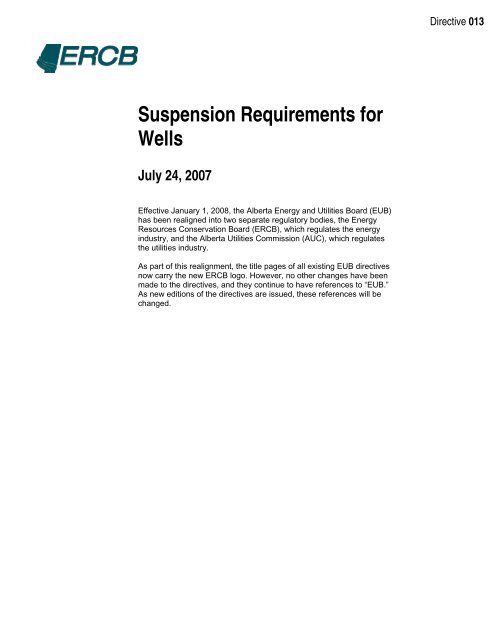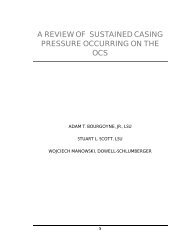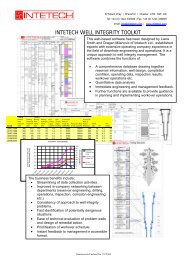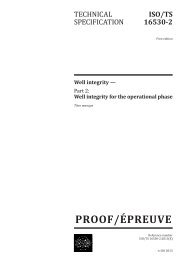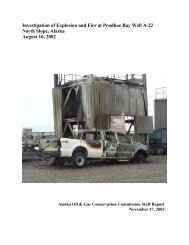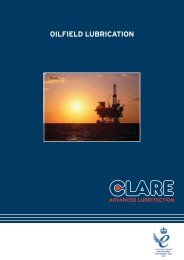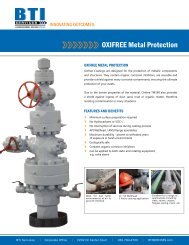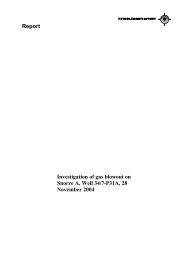Directive 013: Suspension Requirements for Wells - Well Integrity ...
Directive 013: Suspension Requirements for Wells - Well Integrity ...
Directive 013: Suspension Requirements for Wells - Well Integrity ...
Create successful ePaper yourself
Turn your PDF publications into a flip-book with our unique Google optimized e-Paper software.
<strong>Directive</strong> <strong>013</strong><strong>Suspension</strong> <strong>Requirements</strong> <strong>for</strong><strong><strong>Well</strong>s</strong>July 24, 2007Effective January 1, 2008, the Alberta Energy and Utilities Board (EUB)has been realigned into two separate regulatory bodies, the EnergyResources Conservation Board (ERCB), which regulates the energyindustry, and the Alberta Utilities Commission (AUC), which regulatesthe utilities industry.As part of this realignment, the title pages of all existing EUB directivesnow carry the new ERCB logo. However, no other changes have beenmade to the directives, and they continue to have references to “EUB.”As new editions of the directives are issued, these references will bechanged.
ENERGY RESOURCES CONSERVATION BOARD<strong>Directive</strong> <strong>013</strong>: <strong>Suspension</strong> <strong>Requirements</strong> <strong>for</strong> <strong><strong>Well</strong>s</strong>July 24, 2007Published byEnergy Resources Conservation Board640 – 5 Avenue SWCalgary, AlbertaT2P 3G4Telephone: 403-297-8311Fax: 403-297-7040Publications@ercb.caWeb site: www.ercb.ca
<strong>Directive</strong> <strong>013</strong>Revised edition July 24, 2007<strong>Suspension</strong> <strong>Requirements</strong> <strong>for</strong> <strong><strong>Well</strong>s</strong>The Alberta Energy and Utilities Board (EUB/Board) has approved this directive on July 24, 2007.[Original signed by]B. T. McManus, Q.C.Acting ChairmanContents1 <strong>Suspension</strong> <strong>Requirements</strong> <strong>for</strong> <strong><strong>Well</strong>s</strong>..........................................................................................12 Definitions.................................................................................................................................23 <strong>Well</strong> Categories and <strong>Requirements</strong> ...........................................................................................24 Reactivating Suspended <strong><strong>Well</strong>s</strong> ..................................................................................................45 Long-Term <strong>Suspension</strong> <strong>Requirements</strong> ......................................................................................46 Suspended <strong><strong>Well</strong>s</strong> Relating to Isolation Packer Testing and Surface Casing Vent Flows..........57 Audit and En<strong>for</strong>cement Process ................................................................................................58 Reporting and Repair <strong>Requirements</strong> .........................................................................................59 Procedure and Schedule to Bring <strong><strong>Well</strong>s</strong> into Compliance ........................................................6Appendix Classifying Suspended Gas <strong><strong>Well</strong>s</strong>..............................................................................71 <strong>Suspension</strong> <strong>Requirements</strong> <strong>for</strong> <strong><strong>Well</strong>s</strong>This Alberta Energy and Utilities Board (EUB) directive sets out the requirements <strong>for</strong> thesuspension of inactive wells.1.1 What’s New in This EditionUpdates in this edition of the directive cite compliance in<strong>for</strong>mation in <strong>Directive</strong> 019: EUBCompliance Assurance—En<strong>for</strong>cement, with references to the matrix of risk items on the EUBWeb site where applicable. References to other EUB published documents have also beenupdated as required.EUB <strong>Directive</strong> <strong>013</strong>: <strong>Suspension</strong> <strong>Requirements</strong> <strong>for</strong> <strong><strong>Well</strong>s</strong> (July 2007) • 1
2 DefinitionsThis directive replaces the following documents, which are rescinded:• Interim <strong>Directive</strong> (ID) 90-4: <strong>Suspension</strong> Guidelines <strong>for</strong> Inactive <strong><strong>Well</strong>s</strong>, and• Interim <strong>Directive</strong> (ID) 91-5: <strong>Suspension</strong> Guidelines Compliance Schedule andApplication <strong>Requirements</strong> <strong>for</strong> Inactive <strong><strong>Well</strong>s</strong>.For the purpose of this directive and the associated required practices, inactive wells aredefined as follows:• inactive critical sour and inactive acid gas wells—wells that have not reported any type ofvolumetric activity (production, injection, or disposal) <strong>for</strong> 6 consecutive months; and• all other inactive wells—wells that have not reported any type of volumetric activity(production, injection, or disposal) <strong>for</strong> 12 consecutive months.For the purpose of this directive, critical sour wells have been divided into four categories,based on hydrogen sulphide (H 2 S) release rates in proximity to urban centres, and are definedas follows:1) H 2 S release rate of 0.01 cubic metres per second (m 3 /s) or greater and less than 0.1 m 3 /sand located within 500 m of the corporate boundaries of an urban centre, or2) H 2 S release rate of 0.1 m 3 /s or greater and less than 0.3 m 3 /s and located within 1.5kilometres (km) of the corporate boundaries of an urban centre, or3) H 2 S release rate of 0.3 m 3 /s or greater and less than 2.0 m 3 /s and located within 5 km ofthe corporate boundaries of an urban centre, or4) H 2 S release rate of 2.0 m 3 /s or greater.3 <strong>Well</strong> Categories and <strong>Requirements</strong>Table 1 describes the suspension requirements <strong>for</strong> all inactive wells according to which ofthree risk levels the well falls into.<strong><strong>Well</strong>s</strong> in a particular risk category may also be suspended in accordance with therequirements of any higher risk category.For wells with multiple zones:• the well must be classified as per the highest risk zone in the wellbore that has not beencompletely and properly abandoned, in accordance with <strong>Directive</strong> 020: <strong>Well</strong>Abandonment Guide (i.e., a bridge plug capped with 8 m of cement);• if all zones are abandoned (the well has not yet been surface abandoned), the shallowestcompletion shall be used to classify the risk category <strong>for</strong> the well.A licensee may request an extension of a deadline or a variance from technical requirementsset out in this directive by submitting an application to the EUB <strong>Well</strong> Operations Section <strong>for</strong>review and disposition. Licensees requiring assistance regarding these requirements shouldcontact EUB <strong>Well</strong> Operations at (403) 297-5290.2 • EUB <strong>Directive</strong> <strong>013</strong>: <strong>Suspension</strong> <strong>Requirements</strong> <strong>for</strong> <strong><strong>Well</strong>s</strong> (July 2007)
Table 1. <strong>Suspension</strong> requirements <strong>for</strong> all inactive wellsLow-risk well Medium-risk well High-risk well<strong>Well</strong> typesDownholerequirementsInspection/monitoring/pressure testingrequirementsInspectionfrequencyReportingType 1. Noncritical sour cased wells - no per<strong>for</strong>ations.Type 2. Gas wells < 28 000 m 3 /day 1 that are low risk (seethe appendix).Type 3. Water source wells.Type 4. Class 4 injectors (see <strong>Directive</strong> 051 2 , Section 2).Type 5. Nonflowing 3 oil wells with an H 2 S content< 50 moles per kilomole (mol/kmol).There are no downhole requirements, as these wells donot pose a significant risk while suspended.Type 1. Pressure test casing to 7 megapascals (MPa) <strong>for</strong>10 minutes.Type 2, 3, 4, 5. Read and record shut-in tubing pressure(SITP) and shut-in casing pressure (SICP).Types 1,2,3,4 – 5 years.Type 5 – 1 year.Type 1. Gas wells that are medium risk (see theappendix)Type 2. Nonflowing 2 oil wells > 50 mol/kmol H 2 S.Type 3. Flowing oil wells.Type 4. Class 2 & 3 injection, carbon dioxide (CO 2 )injection/disposal wells (see <strong>Directive</strong> 051, Section 2).Type 5. Class 1B waste disposal wells (see <strong>Directive</strong>051, Section 2), and cavern service wells.Type 6. Completed low-risk wells suspended longerthan 10 years.Option 1. Packer and a tubing plug.Option 2. Bridge plug.Option 3. Type 5 cavern service wells only. All productto be evacuated from the cavern and replaced withsaturated brine. All hanging tubing/casing strings to beremoved and a bridge plug set.Option 1. Pressure test annulus and tubing to 7 MPa <strong>for</strong>10 minutes.Option 2, 3. Pressure test casing to 7 MPa <strong>for</strong> 10minutes.Option 1 – 3 years.Option 2,3 – 5 years.Type 1. Critical sour wells, per<strong>for</strong>ated or not.Type 2. Acid gas wells.Type 3. Class 1A waste disposal wells (see <strong>Directive</strong>051, Section 2).Option 1. Packer and a tubing plug.Option 2. Bridge plug capped with 8 m lineal cement.Option 1. Pressure test annulus and tubing to 7 MPa <strong>for</strong>10 minutes.Option 2. Pressure test casing to 7 MPa <strong>for</strong> 10 minutes.Option 1 – 1 year.Option 2 – 5 years.Within 30 days after completion of inspection or suspension operations. Within 30 days after resumption of production/injection.<strong>Well</strong>bore fluid None <strong>Well</strong>bore fluid is to be inhibited with a nonfreezing fluid in the top 2 m.<strong>Well</strong>heads Unper<strong>for</strong>ated wells may use a welded steel plate atop theproduction casing stub. The plate must provide access tothe wellbore <strong>for</strong> pressure measurement.Per<strong>for</strong>ated wells are to have standard wellheads.<strong>Well</strong>headmaintenanceSecuritySurface casingvent flowsStandard wellheads as outlined in Oil and Gas Conservation Regulations. 6.100(3), 6.130(1)(2), 7.050(3), 7.060(8),ID 98-02, ID 97-6, IRP (ARP) 2, IRP 5 and API - 6A. CSA Z341 (Caverns)There shall be no wellhead leaks. Regular wellheads require servicing and pressure testing of sealing elements at time of suspension and at each subsequent inspection. Alloutlets except surface casing vents are to be bull plugged or blind flanged with needle valves. Valves must be functional (open/close). Grease and service as required to maintainfunctionality.All wellheads are to be conspicuously marked or fenced such that they are visible in all seasons with well identification sign in plain view. In agricultural areas, farming operationsmust be restricted to safe distances from the wellhead. Pumpjacks must be left in a secure condition. Valve handles must be chained and locked, or as an alternative, valvehandles may be removed.Systems must be open and comply with the Oil and Gas Regulations 6.100 (1) (2) (3).Vent flows, if detected, are to be handled as described in ID 2003-01: 1) Isolation Packer Testing, Reporting, and Repair <strong>Requirements</strong>; 2) Surface Casing Vent Flow/GasMigration Testing, Reporting, and Repair <strong>Requirements</strong>; 3) Casing Failure Reporting and Repair <strong>Requirements</strong>.1This flow rate is the stabilized wellhead absolute open flow (AOF).2<strong>Directive</strong> 051: Injection and Disposal <strong><strong>Well</strong>s</strong> – <strong>Well</strong> Classifications, Completions, Logging and Testing <strong>Requirements</strong>.3Nonflowing refers to wells without sufficient reservoir pressure to sustain flow against atmospheric pressure without artificial lift. The flowing product is a fluid.EUB <strong>Directive</strong> <strong>013</strong>: <strong>Suspension</strong> <strong>Requirements</strong> <strong>for</strong> <strong><strong>Well</strong>s</strong> (July 2007) • 3
4 Reactivating Suspended <strong><strong>Well</strong>s</strong>The following are the required procedures <strong>for</strong> the reactivation of a suspended well.All wells• Inspect, service, and pressure test the wellhead.• Inspect and service control systems and lease facilities.• Report reactivation of well on the Digital Data Submission (DDS) system and retainrecords.Medium and High-Risk <strong><strong>Well</strong>s</strong>• Pressure test the casing to 7 MPa <strong>for</strong> 10 minutes. If this test fails, then the problem mustbe investigated and repaired.• If tubing is present, pressure test the tubing to 7 MPa <strong>for</strong> 10 minutes. If this test fails, thenthe problem must be investigated and repaired.A well attains active status after it has operated <strong>for</strong> a minimum of 360 hours (15 days)per month <strong>for</strong> 3 consecutive months.5 Long-Term <strong>Suspension</strong> <strong>Requirements</strong>All completed low-risk wells must meet suspension requirements <strong>for</strong> medium-risk wells afterbeing suspended <strong>for</strong> 10 consecutive years after the first year of inactivity commencingDecember 31, 2007. The following examples demonstrate the timing of the long-termsuspension requirements.Example 1: A low-risk oil well that last reports production in December 2005• On December 31, 2006, the licensee will have 60 days to suspend the well in accordancewith the low-risk well requirements of this directive.• The suspension operations must be reported within 30 days following the suspensionoperations.• On December 31, 2016, if the well is still suspended, the licensee will have 60 days tosuspend this well in accordance with the medium-risk well requirements of this directive.Example 2: A low-risk oil well that last reports production in December 1994• As of December 31, 2007, if the well is still suspended, the well must be suspended inaccordance with the medium-risk well requirements of this directive.All low-risk wells whose 10-year anniversary of inactivity occurs after December 31, 2007,must be suspended in accordance with the medium-risk well requirements no later than 60days after the anniversary date.All low-risk wells whose 10-year anniversary of inactivity occurs be<strong>for</strong>e December 31, 2007,must be suspended in accordance with the medium-risk well requirements by December 31,2007.4 • EUB <strong>Directive</strong> <strong>013</strong>: <strong>Suspension</strong> <strong>Requirements</strong> <strong>for</strong> <strong><strong>Well</strong>s</strong> (July 2007)
6 Suspended <strong><strong>Well</strong>s</strong> Relating to Isolation Packer Testing and Surface Casing Vent FlowsPacker Testing• <strong><strong>Well</strong>s</strong> that are suspended are to be removed from the packer testing system and therequirements of this directive must be met.Surface Casing Vent Flow/Gas Migration• The suspension of a well does not change any of the requirements of ID 2003-01.7 Audit and En<strong>for</strong>cement ProcessThe licensee must keep all test results and suspension details <strong>for</strong> suspended wells until wellabandonment. The EUB will use an audit system to confirm the licensee’s compliance and tohelp measure the effectiveness of the suspension process. Upon written notification that thewell has been selected <strong>for</strong> audit, the licensee must submit the required in<strong>for</strong>mation within 20days.The EUB’s en<strong>for</strong>cement process is specified in <strong>Directive</strong> 019: EUB Compliance Assurance-En<strong>for</strong>cement. A list of risk-assessed noncompliances is available on the Web at EUBHome : Industry Zone : Compliance and En<strong>for</strong>cement : Risk Assessed Noncompliance.8 Reporting and Repair <strong>Requirements</strong>Inactive wells must be suspended according to the requirements of this directive within 60days after the one-year anniversary of no production or injection. The suspension must bereported to the EUB via DDS within 30 days of the suspension operations or inspection. Thereactivation of a well from suspension must be reported to the EUB via DDS within 30 daysfollowing the resumption of production or injection of the well.For example, if a gas well’s last production occurs April 29, 2003, the well must besuspended in compliance with requirements by June 28, 2004. The suspension must then bereported to the EUB DDS system within 30 days following completion of suspensionoperations.Critical sour wells must be properly suspended within 6 months, as set out in ID 90-1:Completion and Servicing of Sour Gas <strong><strong>Well</strong>s</strong> and reported within 30 days from the last day ofsuspension operations being completed.The data elements required to be submitted include the following:<strong>Suspension</strong> date Inhibitor program Casing failure detected<strong>Suspension</strong> class (risk) Inspection date <strong>Well</strong>head failure detected<strong>Well</strong> operational type Inspection reason Inspection outcomeDownhole operation Packer/plug failure detected Remedial work completedH 2 S content (%)Gas migration detectedCO 2 content (%)Vent flow detectedEUB <strong>Directive</strong> <strong>013</strong>: <strong>Suspension</strong> <strong>Requirements</strong> <strong>for</strong> <strong><strong>Well</strong>s</strong> (July 2007) • 5
9 Procedure and Schedule to Bring <strong><strong>Well</strong>s</strong> into Compliance<strong><strong>Well</strong>s</strong> that are in the inventory of inactive wells at the time of issuance of this directive mustbe brought into compliance and reported according to the following schedule:• All high-risk wells are to be in compliance with the requirements of this directive byDecember 31, 2005.• All medium- and low-risk wells are to be in compliance with the requirements of thisdirective by December 31, 2006.The reporting of these wells (both initially and following inspections) may be done by a batchupload available on the EUB Web site at https://www3.eub.gov.ab.ca/eub/dds.Licensees having difficulty meeting the above schedule should contact EUB <strong>Well</strong> Operationsat (403) 297-5290 prior to the deadline to discuss options available to meet the complianceexpectations.Critical sour wells must be properly suspended within 6 months, as set out in ID 90-1.6 • EUB <strong>Directive</strong> <strong>013</strong>: <strong>Suspension</strong> <strong>Requirements</strong> <strong>for</strong> <strong><strong>Well</strong>s</strong> (July 2007)
AppendixClassifying Suspended Gas <strong><strong>Well</strong>s</strong>In order to classify the risk of gas wells containing H 2 S, the EUB equation <strong>for</strong> the emergencyplanning zone (EPZ) is used.The following equation <strong>for</strong> low H 2 S release rates (0.01 m 3 /s


